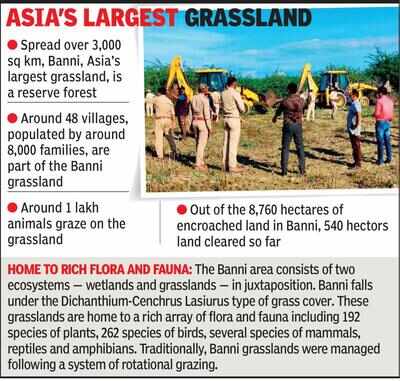BANNI GRASSLANDS
Introduction
- Banni grasslands form a belt of the arid grassland ecosystem on the outer southern edge of the desert of Rann of Kutch, in Kutch district, Gujarat.
- They are known for rich wildlife and biodiversity and spread across an area of 3,847 sq. kilometres.
- It is situated from 230 19 N to 68052 E.

Context
- The Gujarat forest department will restore 10,000 hectares of the Banni grasslands in the coming year and every year in the coming decade.
- The state plans on restoring at least 76,000 hectares of this 2,497 sq km grassland which already restored 10,000 hectares over the past couple of years.
Restoration:
- At the United Nations High-Level Dialogue on Desertification, Land Degradation and Drought last year, a target of restoring 26 million hectares of degraded land by 2030 was flagged.
- Forest officials say that the project was begun in 2015-16.
- The landscape of Banni has shown drastic changes with the deterioration of the grassland due to heavy uncontrolled grazing, widespread Prosopis juliflora (harmful exotic species), dams constructed on rivers flowing towards Banni, periodic occurrence of droughts and continuous increase in soil salinity.
- In the year1989, this area was dominated by grasslands covering 54.57% of the area followed by saline areas devoid of vegetation or sparsely distributed vegetation covering 27.30% and Prosopis juliflora an alien invasive species covering 15.72% of the area.
- The Land Use Land Cover(LULC) assessment of the grassland over a 10 years interval revealed that grassland areas over the period gradually reduced, while Prosopis juliflora has increased, encroached more than 30%.
- Within a gap of 20 years, Prosopis juliflora dominant areas doubled in Banni.
- The mainstay of the restoration project is the removal of this alien species which incidentally was introduced to the area by the forest department in the 1960s to stop the ingress of the salt flats.
- With a huge 20 lakh livestock population that depends on grassland, the second part of the project envisions the production and storing of fodder for local farming.
- There exists a huge gap in demand & supply of fodder, making the livelihood of locals difficult.
- The forest division has been given a target to bring 2400 hectares under controlled grass cultivation in 2022-23 by the state government.
- This was achieved by creating 27 grass plots of varying size and cumulatively covering 2400 hectares.
- Prosopis juliflora and other unwanted vegetation were removed from these plots and a protective trench was dug around them.

Banni Grasslands
- Banni region emerged from the sea as a result of tectonic activities, received soils from the rivers flown from Bhutto mainland and ends in greater Rann of Kutch.
- Soils deposited by the rivers and the wind, made the land of Banni richer enough that could generate diverse grass species(40 species).
- Banni grassland supports numerous animal genetic resources like Banni buffalo, Kankrej Cattle, Sheep, Goat, Camel, and Horse.
- This grassland acts as a breeding and nesting space for more than 250 bird species, including resident and migratory birds.
- The maximum temperature ranges to 48-500 C during May and June; winter temperature goes down to 5-80 C during December and January.
- Average annual rainfall is very low at 317 mm with a coefficient of variation of 65%.
- Though there is inherent salinity in the soil, pastoral communities dug up birds, shallow wells of 9-12 feet deep that collect rainfall in its soil particle, for livestock and themselves.
- There are many natural wetlands, the largest one is known as Chhari-Dhandh, a saucer-shaped wetland which is recently declared a Conservation Reserve.
- Banni grasslands are responsible for the increase in salinity.
- Though the grassland is facing ecological disturbances, the recent recognition of the Banni Buffalo breed of country, establishment of dairies, and good rainfall generated hope.



